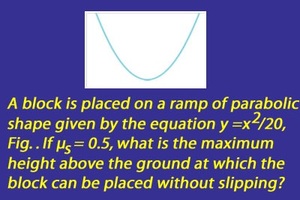This section requires Javascript.
You are seeing this because something didn't load right. We suggest you, (a) try
refreshing the page, (b) enabling javascript if it is disabled on your browser and,
finally, (c)
loading the
non-javascript version of this page
. We're sorry about the hassle.
2 solutions
Why isn't m g cos θ = μ s m g sin θ instead?
Log in to reply
The block is moving down the ramp due to the force of m g sin θ . The frictional force, resisting the downward force, is μ s N , where N is the normal force N = m g cos θ , therefore, the frictional force is μ s m g cos θ . Check out equation 3 here .
Because the force of friction is the coefficient of friction μ s times the normal force to the ramp, not the coefficient of friction multiplied by the force tangential to the ramp.
Since co-efficient of friction is 0.5 hence tan(theta(max))=1/2. Now tan(theta)=dy/dx=x/10.Now x/10<1/2 hence X(max)=5. So y(max)=25/20=1.25
I did it in the same way .

The frictional force decreases going up the slope. The highest point with an inclination of θ with the horizontal where the block of mass m can be placed without slipping is when the downward force is balanced by the frictional force as follows:
m g sin θ = μ s m g cos θ ⇒ tan θ = μ s = 0 . 5
Since, tan θ = d x d y = 2 0 2 x = 1 0 x .
And when tan θ = 0 . 5 ⇒ 1 0 x = 0 . 5
⇒ x = 5 ⇒ y = 2 0 2 5 = 1 . 2 5